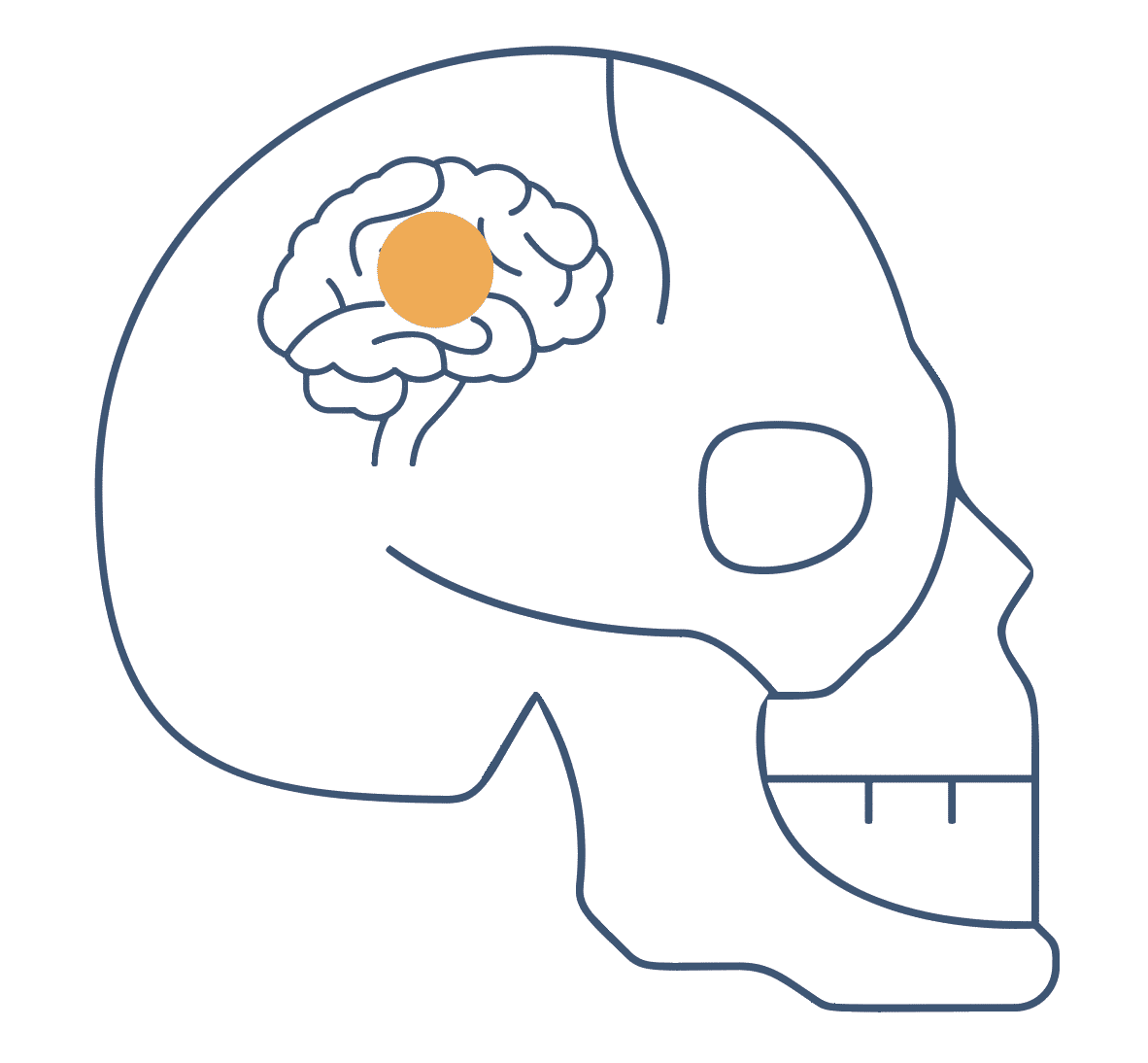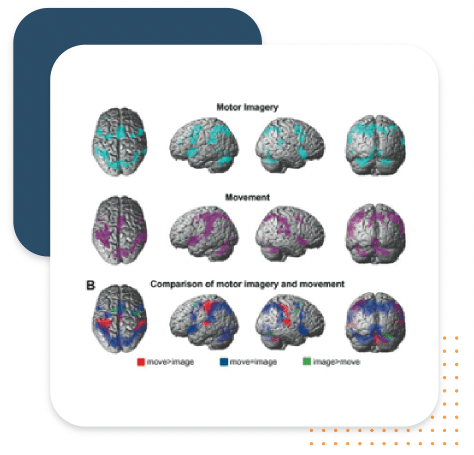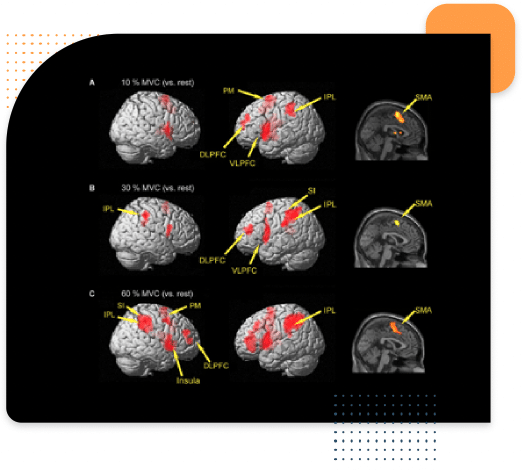Allyane scientific data
The clinical studies

Management of AMI (Arthrogenic Muscle Inhibition) following knee trauma;

Range of motion deficit following shoulder surgery;

Motor skills and pain in chronic low back pain ;

Ankle instability ;

Spasticity and motor skills following stroke**.
Chatain AL, Dorochenko P, Friggeri A. Contribution of an innovation in neuromotor reprogramming in shoulder pathologies. Poster presented at the 45th national congress of the French Society of Sports Physiotherapists SFMKS, SFPhysio. Saint-Etienne, France, 28/04/2018.
Chatain AL, Gonzalez Iglesias I, Friggeri A. Innovating in the management of spasticity with a non-invasive procedure. Kinesitherapy Scientific 2018; 599:37-41, France, June 2018.
See more publications
Chatain AL, Friggeri A. Innovating in the management of spasticitý. Poster presented at̀ la 1è̀re journée
française de neurokinésithé́rapie, SFPhysio. Marseille, France, 22/09/2018.
Friggeri A, Le Blay G Neuro-cognitive reprogramming in mechanical pathologies of the
locomotor system according to the Allyane process. Paper and workshop at the 12th SOFMMOO national congress, October 2018
Friggeri A, Le Blay G Neuro-cognitive reprogramming in the rehabilitation of chronic low back pain. Poster
presented at the 34th congress of the French Society of Rehabilitation Medicine SOFMER, October 2019
Chatain AL, Contribution of neuro-cognitive reprogramming in the management of spasticitý. Poster
presented at the 2nd Days of the French Neurovascular Society SFNV, Issy les Moulineaux, Nov 2019.
Jean Baptiste Colombié, PT, AT, A new way to change dance motor patterns: the Allyane process. Poster
presented at the 29th International Conference of the International Association for Dance Medicine & Science,
Montreal, Quebec, Canada, Oct 2019.
Chatain AL, Contribution of neuro-cognitive reprogramming in the management of spasticitý.
Paper and e-poster at the e-JNLF 4-6 September 2020.
Chatain AL, Impact of neuro-cognitive reprogramming in spasticity rehabilitation. Accepted poster in the ESO-
WSO Virtual Conference, 7-9 november 2020
Ladoucette S., Arthrogenic Muscle Inhibition: a new approach in joint rehabilitation. ECOSEP Congress Sports
Medicine and Science : Facts for the future, 19-20 November 2021, Athens
Dumain JF, Neuromotor reprogramming treatment modality for ankle sprain: a case report. Communication at XXIX Isokinetic Medical Group Conference, June 2022, Lyon France
Ladoucette S, Arthrogenic Muscle Inhibition: A novel approach in joint rehabilitation. Poster in XXIX Isokinetic Medical Group Conference, June 2022, Lyon France
Dos Anjos T, Motor Imagery for neuromuscular deficits after ACL injury: a review. Communication at XXIX Isokinetic Medical Group Conference, June 2022, Lyon France
Gabriel F, Dos Anjos T, Hopper GP, Sonnery-Cottet B, Neuromotor treatment of arthrogenic muscle inhibition following knee injury or surgery. Communication at XXIX Isokinetic Medical Group Conference, June 2022, Lyon France
Typhanie Dos Anjos, Aymeric Guillot, Yann Kerautret, Sébastien Daligault and Franck Di Rienzo, Corticomotor Plasticity Underlying Priming Effects of Motor Imagery on Force Performance, Brain Sci. 2022, 12(11), 1537
Colombié JB, Ladoucette S, Changing a Reflex Motor Pattern Using the Allyane Technique: Case Report of a Dancer's Chronic Ankle Instability, Journal of Orthopaedic Case Reports 2023 January:13(1):Page 32-36
Braun S, Kitada S, Chatain AL, Impact de la reprogrammation neuromotrice proposée par Allyane,dans le cadre de la spasticité post-AVC, Kinésithérapie La Revue, Vol 23 num 255, 78
Braun S, Kitada S, Chatain AL, Impact of neuromotor reprogramming proposed by Allyane,in post-stroke spasticity. Poster presented at the Journées francophones de kinésithérapie 2023.
Dos Anjos T, Gabriel F, Hopper G, DutraVieira T, Sonnery-Cottet B, Neuromotor Treatment of Arthrogenic Mucle Inhibition Following Knee Injury or Surgery. Accepted in Sports Health 2023
Visit management of AMI in post-knee surgery.
A clinical study presented at the ECOSEP sports medicine congress in November 2021, shows that an Allyane session allows :
- Une augmentation moyenne d’activité musculaire (mesurée par EMG de surface**) de 41% statistiquement significative (p<0,001)
- Une réduction moyenne du flessum de 9,01 degrés statistiquement significative (p<0,001)
* Case series, evidence level 4
** Average of three isometric contractions of the Medial Oblique Vastus

- +17.5% increase in knee function
- +45% activation of the Oblique Medial Vastus
This publication illustrates the need for multidisciplinary management following knee sprains and surgery.
Brain plasticity and listening to low-frequency frequency sounds.*
This publication explores the effects of passive listening to low-frequency sounds, used in the Allyane method protocols, on oscillatory brain activity.
These effects were compared with those of auditory stimuli well documented in the literature, such as binaural sounds and white noise. Brain power and connectivity analyses have shown, for the first time, that the low-frequency sounds emitted by the Alphabox® medical device induce a specific modulation of oscillatory brain activity, with a signature distinct from that of white noise or binaural sounds.
These results confirm the impact of low-frequency sounds on brain activity, their potential interest in improving cognitive functions and their clinical applications.
* Dos Anjos T, Di Rienzo F, Benoit CE, Daligault S, Guillot A. Brain wave modulation and EEG power changes during auditory beats stimulation. Neuroscience. 2024 Jul 14;554:156-166. doi: 10.1016/j.neuroscience.2024.07.014. Epub ahead of print. PMID: 39004412.
DOI: 10.1016/j.neuroscience.2024.07.014

Motor imaging & low-frequency sounds
In this work, we explored the short-term effects of motor imagery, whether or not combined with passive listening to low-frequency sounds, on strength development.
Correlation analyses between performance and brain activity showed that the addition of low-frequency sounds induced neuronal modulation distinct from that induced by motor imagery alone.
The pattern of cortico-motor activity associated with the Imagery + Sound combination supports the hypothesis of motor reprogramming.
These results confirm the value of combining motor imagery and low-frequency sound for improving motor function and in clinical management programs.
*Typhanie Dos Anjos, Aymeric Guillot, Sebastien Daligault, Donna-Maria Chamoun, Thomas De Sousa, Franck Di Rienzo,
Low-frequency sounds combined with motor imagery elicits a transient disruption of force performance: A path to neuromotor reprogramming?
DOI: 10.1016/j.neuroimage.2024.120746
Scientific data
Scientific data on mental imagery

Mental imagery is based on neurofunctional equivalence: thinking about the action involves almost the same areas of the brain as performing the action itself.
Motor imagery influences neuroplasticity, i.e. the ability of neurons to change throughout life. This can have an impact on the intensity of muscle contraction or speed of movement, for example. There is a neurofunctional equivalence between motor imagery and actual execution that is now widely demonstrated by various scientific data.
Hanakawa T, Dimyan MA, Hallett M. Motor planning, imagery, and execution in the distributed motor network: a time-course study with functional MRI.
Cereb Cortex. 2008 Dec;18(12):2775-88. https://doi.org/10.1093/cercor/bhn036. Epub 2008 Mar 20.
Furthermore, we know that neural activity and neuroplasticity are modulated by the quality and precision of the imaging, for example when we imagine a high or low intensity movement or depending on the speed of the movement.
Mizuguchi N, Nakata H, Kanosue K. Activity of right premotor-parietal regions dependent upon imagined force level: an fMRI study. Front Hum Neurosci. 2014 Oct 8;8:810. https://doi.org/10.3389/fnhum.2014.00810. eCollection 2014
Sauvage C1, Jissendi P, Seignan S, Manto M, Habas C. Brain areas involved in the control of speed during a motor sequence of the foot: real movement versus mental imagery. J Neuroradiol. 2013 Oct;40(4):267-80.
https://doi.org/10.1016/j.neurad.2012.10.001. Epub 2013 Feb 21.

Scientific data
Scientific databases on the combination of motor imagery & sound stimulation
Enhancing motor imagery with kinesthetic modalities is more effective than visualization alone.
Scientific research results show that combining sounds with visual or kinesthetic modalities improves therapeutic outcomes. Furthermore, according to various scientific publications, the primary cortex is more active when motor imagery is combined with auditory stimulation.
Fernandez-Del-Olmo, M., Río-Rodríguez, D., Iglesias-Soler, E., & Acero, R. M. (2014). Startle Auditory Stimuli Enhance the Performance of Fast Dynamic Contractions. PLoS ONE, 9(1), e87805. https://doi.org/10.1371/journal.pone.0087805
Ikeda, K., Higashi, T., Sugawara, K., Tomori, K., Kinoshita, H., & Kasai, T. (2012). The effect of visual and auditory enhancements on excitability of the primary motor cortex during motor imagery: A pilot study. International Journal of Rehabilitation Research, 35(1), 82-84. https://doi.org/10.1097/MRR.0b013e32834d2032
In addition, Allyane is developing a strong research activity to objectivise the action of its specific scientific protocols, associated with the low frequency sounds of its medical devices.
Thus, scientific work in EEG (electroencephalography) and MEG (magnetoencephalography) is underway to objectify the action and brain activation pathways induced by the Allyane method.

